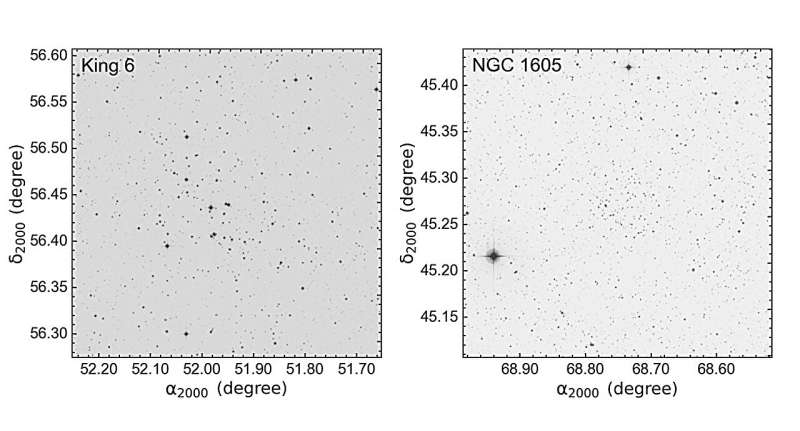November 13, 2023 report
This article has been reviewed according to Science X's editorial process and policies. Editors have highlighted the following attributes while ensuring the content's credibility:
fact-checked
preprint
trusted source
proofread
Study investigates two young open clusters

By analyzing the data from the TÜBİTAK National Observatory and ESA's Gaia satellite, astronomers have investigated King 6 and NGC 1605—two young Galactic open clusters. Results of the study, published October 31 on the pre-print server arXiv, deliver important insights into the properties and nature of these clusters.
Open clusters (OCs), formed from the same giant molecular cloud, are groups of stars loosely gravitationally bound to each other. So far, more than 1,000 of them have been discovered in the Milky Way, and scientists are still looking for more, hoping to find a variety of these stellar groupings. Expanding the list of known galactic open clusters and studying them in detail could be crucial for improving our understanding of the formation and evolution of our galaxy.
Located in the second Galactic quadrant, King 6 and NGC 1605 are globular clusters studied for decades. However, although many observations of these clusters have been conducted, many of their properties remain uncertain or unknown. For instance, there is a big discrepancy in the data when it comes to the age as some studies suggest that King 6 and NGC 1605 may be as young as 40 million years, while some observations indicate that they may be even a few hundred million years older.
The distance to the clusters is also debated as the results point to 1,500–2,800 light years for King, and 3,700–10,800 for NGC 1605.
That is why a team of astronomers led by Sevinc Gokmen of the Florida Atlantic University in Boca Raton, Florida, decided to take a closer look at these two OCs. For this purpose they analyzed the observational data from the 1-m T100 telescope at the TÜBİTAK National Observatory and from the Gaia Data Release 3 (DR3).
The team identified 112 member stars of King 6 and 160 member stars of NGC 1605 by employing the Unsupervised Photometric Membership Assignment in Stellar Clusters (UPMASK) algorithm on the astrometric data from DR3. These stars were used to estimate astrophysical parameters of the two clusters.
The study found that King 6 is about 200 million years old and is located approximately 2,360 light years away from the Earth. The cluster has a radius of some 6.85 light years and its total mass is estimated to be 195 solar masses. The metallicity of King 6 was measured to be at a level of 0.02 dex.
When it comes to NGC 1605, the results indicate that the cluster is about 400 million years old and located 9,700 light years away. NGC 1605 turned out to be much larger and more massive than King 6—with a radius of approximately 29 light years and a total mass of 623 solar masses. The cluster's metallicity was found to be 0.01 dex.
By analyzing the orbits of King 6 and NGC 1605, the astronomers concluded that both OC belong to the young thin-disk population of the galaxy and formed outside the solar circle. They added that mass segregation is observed in the two clusters and that they are both dynamically relaxed.
More information: Gokmen et al, CCD UBV and Gaia DR3 Analyses of Open Clusters King 6 and NGC 1605, arXiv (2023). DOI: 10.48550/arxiv.2311.00054
Journal information: arXiv
© 2023 Science X Network





















